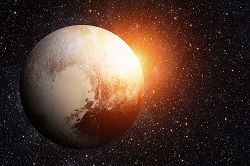Trending Science: Dunes on Pluto? Maybe the dwarf planet is more like Earth
In 2015, NASA’s New Horizons spacecraft flew past Pluto and captured images of its active surface. The scientific community believed that Pluto’s atmosphere wasn’t necessarily robust enough to support the formation of dunes. That was until Jani Radebaugh, an associate professor in geological sciences at Brigham Young University in the United States, decided to have a closer look at the photos. Surprise! Pluto has dunes Radebaugh, with the help of a team of planetary scientists, physicists and geographers, studied NASA’s flyby images. This was followed by numerical and spectral modelling, and spatial analysis. They provided a detailed analysis of Pluto’s surface in the journal ‘Science’. What they didn’t expect to find were dunes, given Pluto’s very thin air. Findings show that the planet has an extensive dune system. The mysterious dunes may look like sand dunes. In reality, they are most probably made of methane ice from nearby mountains. This came as somewhat of a surprise. Scientists had thought Pluto’s winds may not be strong enough to shape such impressive heaps of sand. “I was looking at the top corner of the glacier, right next to the mountains, and I could see long, straight, regular ridges,” study co-author Radebaugh said in a statement. “And as I looked really closely, I thought, those are dunes. There’s no question in my mind those are dunes.” The dunes are spread over an area less than 80 km across. More like Earth than we thought? It seems that Pluto has certain characteristics that resemble our planet. “Despite being 30 times farther away from the sun as the Earth, it turns out Pluto still has Earth-like characteristics,” noted Radebaugh. “We have been focusing on what’s close to us, but there’s a wealth of information in the distant reaches of the solar system too.” “We knew that every solar system body with an atmosphere and a solid rocky surface has dunes on it, but we didn’t know what we’d find on Pluto," added Matt Telfer, study lead author and lecturer in physical geography at the University of Plymouth in the United Kingdom. “It turns out that even though there is so little atmosphere, and the surface temperature is around minus 230 degrees Celsius we still get dunes forming. … It is another piece of the jigsaw in making sense of this diverse and remote body.” A detailed analysis of the surface shows mountains, glaciers and ice moving. There’s evidence of Pluto’s atmosphere shaping the surface of the planet much like on Earth. The dunes were likely formed within the last 500 000 years or so. Telfer told the ‘BBC’ that the findings shed new light on Pluto and also change our view of it: “It’s really exciting just to be able to look at this world and recognise that it’s not just a frozen icy blob in the outer reaches of the solar system but really we’re seeing a dynamic world still changing, still forming today.” The team now plans to carry out computer simulations to help them learn more and to better understand how these dunes were formed.
Countries
United States



